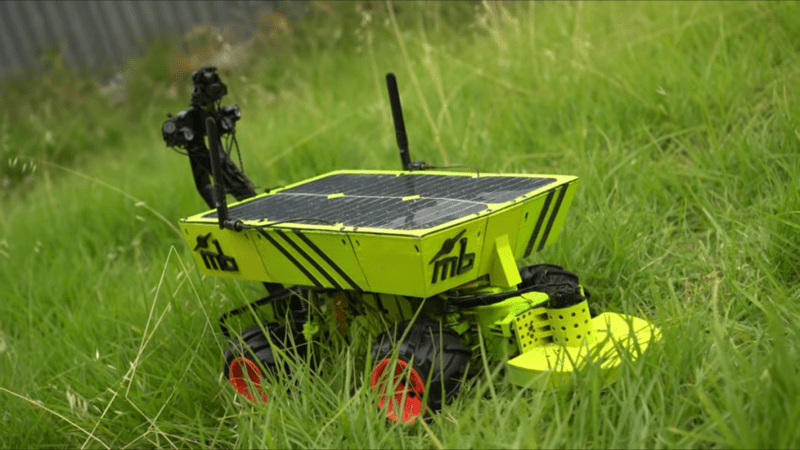Interfacing technology and electronics with the real world is often fairly tricky. Complexity and edge cases work their way in to every corner of a project like this; just ask anyone who has ever tried to operate a rover on Mars, make a hydroponics garden, or build almost any robotics project. Even those of us who simply own a consumer-grade printer are flummoxed by the ways in which they can fail when manipulating single sheets of paper. This robotic lawnmower is no exception, driving its creator [TK] to extremes to get it to mow his lawn.
[TK] actually had a platform for his autonomous mower ready to go thanks to a previous build using this solar-powered robot to explore the Australian outback. Adding another motor to handle the grass trimming seemed simple at first and he set about wiring it all up and interfacing it to the robot. After the first iteration he found the robot was moving too fast to effectively cut the grass, so he added a more powerful cutting motor and a gearbox to help the mower crawl more slowly over the lawn. Disaster struck when his 3D printed mount for the steel cutting blades shattered, but with [TK] uninjured he pushed on with more improvements.
As it stands right now, the mower can effectively cut the grass moving forward even with the plastic-only cutting blades that [TK] is using now for safety reasons. The mower stripped its reverse gear so there still are some improvements to make before this robot is autonomously cutting the lawn without supervision. Normally we see lawnmowers retrofitted with robotics rather than robotics retrofitted with a lawnmower, but we’re excited to see any approach that lets us worry about one less household chore.
Thanks to [Rob] for the tip!
















“Disaster struck when his 3D printed mount for the steel cutting blades shattered”
Some things I would never trust with aq plastic 3D print…
My aunt has a commercial lawnmower robot. It works quite well, but sometimes she notices she hasn’t seen “Robbie” in a while and has to tour the premises to see it fallen off a just-too-steep grade, gotten stuck under a thornbush or just having a general error. “It keeps me in shape”.
What brand is robbie? I’ve never heard of a commercial quality robo-mower before.
They’ve been around for a decade or more, but tend to be way too expensive for what they are.
https://www.husqvarna.com/us/robotic-lawn-mowers/
Worx came out with one a long time ago for CHEAP, then all of a sudden doubled the price.
https://www.worx.com/lawn-garden/robotic-lawn-mowers.html
Sony came out with one for a moment, Roomba and Segway announced one. iMow, Cub Cadet, Gardenea, RoboMow, Ambrogio are really really nice.
Look at the bottom of this: https://www.husqvarna.com/us/robotic-lawn-mowers/?utm_source=Bing&utm_medium=mc_search&utm_campaign=Husqvarna_RoboticsNational&utm_term=all&gclid=32240fc5d7db1340a9ea6dd846475dd2&gclsrc=3p.ds&&MICROSOFTUS~2022~BING~PGE~Brand~Robotics~National+Markets~EXAutomowers_Robotic+Mower+Pricesp66538812739&msclkid=32240fc5d7db1340a9ea6dd846475dd2
Looks good so far.
Even those small brushed DC motors have cooling vents, they look like there covered by the cylinder that holds the motor. A motor should have screw holes somewhere on the end.
If you need real power then convert a car 12V starter motor (the old ones) to a DLDC like they do for go carts. You need to keep it cool so a fan might be useful.
Try to use standard lawn mower blades. Blades have an ideal sharpness where they “burst” through a small section of the blades of grass and the departing grass takes most of the “sap” with it. Too sharp and it will be slowed down by the drag of sap build-up because the cut is too “clean” and there is no ragged edge on the grass to take away the sap, too blunt (or wide) and it’s bursting the grass is two places creating twice the sap and leaving the centre part of the grass on the blade, once again slowing it down.
Blades are supposed to be able to spin on their mounting pivot. This is not critical but it helps when the blade dull (the edges “round” or thick grass leave a lot of sap and gunk. When they don’t cut well the get pushed back and the sliding on the grass (rather than cutting) helps wipe the gunk (sap/grass) off the edge of the blade then when it returns to normal position it is travelling faster than normal.
pretty sure you mean alternator or starter-generator; dedicated Starter Motors are brushed DC
Yeah, Alternator. Plenty of you tube videos on the conversion. Some do Starter motor (power) modifications but not to BLDC.
Thanks.
Ardumower has plenty of good resources: https://www.ardumower.de/en/
One thing I notice about autonomous mowers as compared to actual mowers, is they general depend on cutting grass in a 360deg pattern, which requires more torque/amps to over come. Most gas mowers use an angled deck which keeps only the leading edge in the grass to be cut when moving forward. The angle also helps thrash the cut blades around to be fine mulch in mulching machines. As I start my build I am looking at is there real benefit in keeping this design philosophy with an autonomous mower, would be interested in a test comparing amp draw in the different configurations.